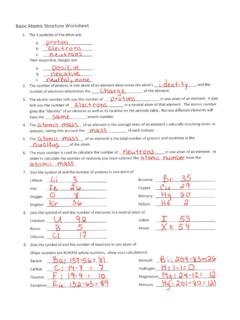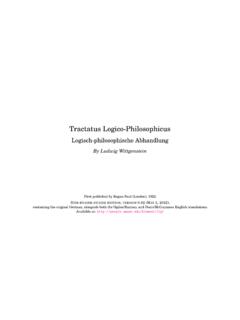Transcription of The Manhattan Project - Office of Scientific and Technical ...
1 5 TheManhattan ProjectNational Security History Series 5 Visit our Manhattan Project web site: RevisedF. G. GoslingOffice of History and Heritage ResourcesExecutive SecretariatOffice of ManagementDepartment of EnergyJanuary 2010 TheManhattan ProjectNational Security History Series 5 National Security History SeriesVolume I: The Manhattan Project : Making the atomic BombVolume II: Building the Nuclear Arsenal: Cold War Nuclear Weapons Development and Production, 1946-1989 (in progress)Volume III: Nonproliferation and Stockpile Stewardship: The Nuclear Weapons Complex in the Post-Cold War World (projected)The National Security History Series is a joint Project of the Office of History and Heritage Resources and the National Nuclear Security to the 2010 editionIn a national survey at the turn of the millennium, journalists and historians ranked the dropping of the atomic bomb and the surrender of Japan to end the Second World War as the top story of the twentieth century.
2 The advent of nuclear weapons, brought about by the Manhattan Project , not only helped bring an end to World War II but ushered in the atomic age and determined how the next war the Cold War would be fought. The Manhattan Project also became the organizational model behind the impressive achievements of American big science during the second half of the twentieth century, which demonstrated the relationship between basic Scientific research and national edition of the Office of History s perennial bestseller is part of a joint Project between the Office of History and Heritage Resources and the National Nuclear Security Administration to produce a three-volume National Security History Series documenting the Department of Energy s role in developing, testing, producing, and managing the Nation s nuclear arsenal.
3 There will be hard copy and online versions of each volume as well as complementary websites. The first website The Manhattan Project : An Interactive History is available on the Office of History and Heritage Resources website, The Office of History and Heritage Resources and the National Nuclear Security Administration hope that the National Security History Series will provide the Department and the public with reliable and useful information about the national security policies and programs of the Department and its predecessor De VosDirectorOffice of the Executive SecretariatF. G. GoslingChief HistorianOffice of History and Heritage ResourcesThomas P. D AgostinoAdministratorNational Nuclear Security Administration55 Table of ContentsIntroduction: The Einstein Letter---------------------------------- ----------------viiPart I: Physics Background, 1890-1939------------------------------- -------------1 Part II: Early Government Support--------------------------------- ---------------6 Part III: The Manhattan Engineer District-------------------------------- --------15 Part IV: The Manhattan Engineer District in Operation-------------------------20 Manhattan Project Photo Gallery--------------------------------- ------------ 36 - 73 Part V: The atomic Bomb and American Strategy-------------------------------8 7 Part VI.
4 The Manhattan District in Peacetime------------------------------- -----99 Manhattan Project Chart----------------------------------- ------------------------103 Notes----------------------------------- ---------------------------------------- ----- 104 Select Bibliography---------------------------- --------------------------------------10 6 Manhattan Project Chronology------------------------------ ----------------------107v55 IntroductionIntroduction: The Einstein LetterOn October 11, 1939, Alexander Sachs, Wall Street economist and longtime friend and unofficial advisor to President Franklin Delano Roosevelt, met with the President to discuss a letter written by Albert Einstein the previous August. Einstein had written to inform Roosevelt that recent research on chain reactions utilizing uranium made it probable that large amounts of power could be produced by a chain reaction and that, by harnessing this power, the construction of extremely powerful bombs was Einstein believed the German government was actively supporting research in this area and urged the United States government to do likewise.
5 Sachs read from a cover letter he had prepared and briefed Roosevelt on the main points contained in Einstein s letter. Initially the President was noncommittal and expressed concern over locating the necessary funds, but at a second meeting over breakfast the next morning Roosevelt became convinced of the value of exploring atomic drafted his famous letter with the help of the Hungarian migr physicist Leo Szilard, one of a number of European scientists who had fled to the United States in the 1930s to escape Nazi and Fascist repression. Szilard was among the most vocal of those advocating a program to develop bombs based on recent findings in nuclear physics and chemistry. Those like Szilard and fellow Hungarian refugee physicists Edward Teller and Eugene Wigner regarded it as their responsibility to alert Americans to the possi-bility that German scientists might win the race to build an atomic bomb and to warn that Hitler would be more than willing to resort to such a weapon.
6 But Roosevelt, preoccupied with events in Europe, took over two months to meet with Sachs after receiving Einstein s letter. Szilard and his colleagues interpreted Roosevelt s inaction as unwelcome evidence that the President did not take the threat of nuclear warfare wrote Einstein back on October 19, 1939, informing the physicist that he had set up a committee consisting of civilian and military representatives to study Events proved that the President was a man of considerable action once he had chosen a direction. In fact, Roosevelt s approval of uranium research in October 1939, based on his belief that the United States could not take the risk of allowing Hitler to achieve unilateral possession of extremely powerful bombs, was merely the first decision among many that ultimately led to the establishment of the only atomic bomb effort that succeeded in World War II the Manhattan French, who did important research on fission and the feasibility of chain reactions using uranium in 1939 and early 1940, fell under German occupation in June 1940.
7 The British, who made significant theoretical contributions early in the war, did not have the resources to pursue a full-fledged atomic bomb research program while fighting for their survival. Consequently, the British acceded, reluctantly, to American leadership and sent scientists to every Manhattan Project facility. The Germans, despite Allied fears that were not dispelled until the ALSOS mission in 1944,3 were little nearer to producing atomic weapons at the end of the war than they had been at the beginning of the war. German scientists pursued research on fission, but the government s attempts to forge a coherent strategy met with little Russians built a program that grew increas-ingly active as the war drew to a conclusion, but the first successful Soviet test was not conducted vii5until 1949. The Japanese managed to build several cyclotrons by war s end, but the atomic bomb research effort could not maintain a high priority in the face of increasing scarcities.
8 Only the Americans, late entrants into World War II and protected by oceans on both sides, managed to take the discovery of fission from the laboratory to the battlefield and gain a shortlived atomic I:Physics Background, 1890-1939 The atomic Solar SystemThe modern effort to uncover the inner structure of the atom began with the discovery of the electron by the English physicist J. J. Thomson in 1897. Thomson proved that cathode rays were not some sort of undefined process occurring in ether but were in fact composed of extremely small, negatively charged particles. Dubbed electrons, their exact charge and mass were soon determined by John Townsend and Robert the same time, discoveries relating to the curious phenomenon of radioactivity had also begun to propel atomic research forward. In 1896, the French physicist Antoine Becquerel detected the three basic forms of radioactivity, which were soon named alpha, beta, and gamma by Ernest Rutherford, a student of Thomson from New Zealand.
9 Also in 1896, the husband-and-wife team of Marie and Pierre Curie began work in Paris on the emission of radiation by uranium and thorium. The Curies soon announced their discoveries of radium and polonium. They also proved that beta particles were negatively charged. In 1900, Becquerel realized that beta particles and electrons were the same the first decade of the 20th century, Rutherford began to pull all of this information into a coherent whole. In 1903, he proposed that radioactivity was caused by the breakdown of atoms. In 1908, he correctly identified alpha particles as being the nucleus of helium; and in 1911, along with the German physicist Hans Geiger, Rutherford postulated that electrons orbit an atom s nucleus, much as the planets orbit the sun. The second fundamental atomic particle, the proton, was identified by Rutherford in 1919.
10 The Danish physicist Neils Bohr combined Rutherford s atomic concepts with Max Planck s quantum theory to produce the first modern model of the atom. In 1913, Bohr demonstrated that electrons moved around an atom s nucleus in certain discrete energy shells and that radiation is emitted or absorbed when an electron moves from one shell to another. The following year, Henry Moseley, an English physicist, showed that each element could be identified by its unique atomic number. By the 1910s, then, scientists investigating the inner structure of the atom had come to believe, among other things, that energy exists within the atom. Considered in light of Albert Einstein s 1905 theoretical formula E=mc2 (energy equals mass times the square of the velocity of light) stating that matter and energy were equivalent, this belief held breathtaking possibilities.





